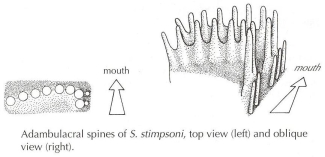Solaster stimpsoni is the most common of the four species of Solaster. It has ten arms (occasionally nine) up to 23 cm long. The body is typically orange or yellow with a blue or purple band on the aboral side of each arm that join at the central disc. Less commonly, the whole body is blue. The ratio of arm to disc is from 2.3 to 4.4. The aboral pseudopaxillae are intermediate in size and number between S. endeca and S. dawsoni, with 6 to 12 peripheral spinelets per pseudopaxilla. The marginals are confined to the oral side of the arms; the wide inferomarginals, at right angles to the arm axis, form an obvious regular row adjacent to the adambulacrals. The superomarginals, just above and between each inferomarginal, are about the same size as the aboral pseudopaxillae. The oral interradial area has pseudopaxillae similar to those on aboral side. A row of oral intermediates runs about one-fifth of the way along the arm. The adambulacrals have 2 or 3 short furrow spines, half as long as the transverse series of 6 to 8 blunt spines on the oral surface. Each pair of mouth plates is broad and shovel-shaped with 6 to 8 heavy marginal spines, larger than any others on the sea star, and one row of 4 to 8 suborals.
Characteristics
Similar SpeciesSolaster endeca may have a striped arm as well, but the arm-to-disc ratio is much smaller than S. stimpsoni.
